Back in 2019, Greg Butler shared insights into MPC‘s visual effects for X-Men: Dark Phoenix. He went on to work on 1917 before bringing his expertise to Method Studios in 2020, contributing to A Babysitter’s Guide to Monster Hunting, Loki, and the first season of The Rings of Power. By 2022, he had moved to DNEG, where he worked on season two of The Rings of Power.
How did you and DNEG get involved on this show?
Before joining DNEG, I was VFX supervisor for Method Studios’ work on the first season of The Rings of Power. DNEG also worked on Season 1 and was already in discussions about Season 2 when I arrived there in Fall 2022.
What was your feeling to be back into this iconic universe?
I thoroughly enjoyed my time on Season 1. It was a great feeling knowing that Season 2 would be very familiar creatively and have the same filmmaking sensibilities. I knew there would be changes given the production move from New Zealand to the UK, but with Jason Smith still overseeing the visual effects, I was confident that we were in good hands. We were also coming out of COVID-19, so there would be more opportunities to work closer together and the whole production would be less disrupted.
The Lord of the Rings has been a big part of my career over the years. I was one of the first international hires for The Fellowship of the Ring in 1999 and worked on all three of the original Peter Jackson films. One of the last shots I was ever assigned as a hands-on digital artist was the last shot to final on The Return of the King, Gollum falling into lava. Mentally inhabiting Middle Earth for a living again after all these years is a constant source of enjoyment and satisfaction. I feel very lucky that I’m able to contribute to the visual lore in a new way. I also enjoy bringing new generations of VFX artists into this kind of work. There are lots of similarities between the projects, a big one is how much people care about the images we’re creating. I remember very well the pressure we felt working on the original films, knowing that the fans of the books would study everything we did, though we didn’t realize for how long! Now we have similar pressure, but for First Age material. And on top of that, people will constantly compare us to the great work done on the original film trilogy.
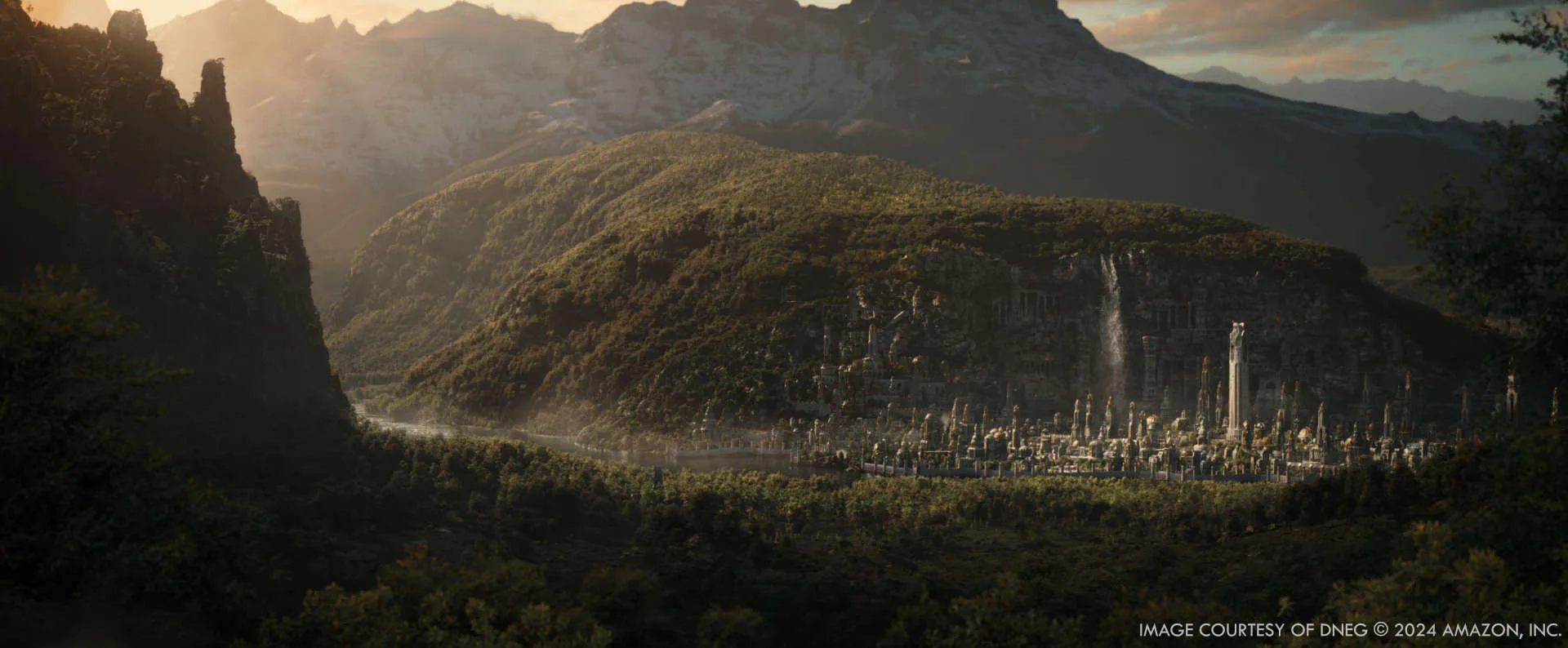
How was the collaboration with the showrunners and VFX Supervisor Jason Smith?
Working with Jason has been great from day one. We have very complimentary backgrounds and skills. Jason takes his responsibilities very seriously and is a great role model for everyone else in the VFX teams. He is endlessly enthusiastic about supporting the stories Patrick McKay and J.D. Payne want to tell. He has earned their trust over the years and the creative briefs and vision are always very clear. His top priority is creating compelling and realistic images that live up to the standards we all have for portraying Tolkien’s world. Second to that though is making sure that the global VFX crews enjoy their time on the project. He is very complimentary to everyone when he sees good work and is always ready to help solve problems as they come up. I’m constantly amazed at how Jason can keep his eyes across so much varied work and maintain a consistent level of energy and quality. I feel my job is to dig in deep to the portion of work assigned to my team. I became an expert in the geography in and around Eregion, Orc costumes, Elven attitudes, and many other details in the DNEG scope of work. It’s been a lot of fun to throw ideas around and see many of them grow into shots or gags within shots. For example, we came up with a quick insert shot in Episode 3. The showrunners wanted to give Damrod’s entrance a little more time and set a mood. We added a long lens shot of the skulls he’s woven into his skirt. It shows he’s the kind of mercenary that carries around souvenirs of past victims, maybe as a warning to others or some kind of score keeping. It’s a creepy little shot we got to invent and give Damrod more screen time.
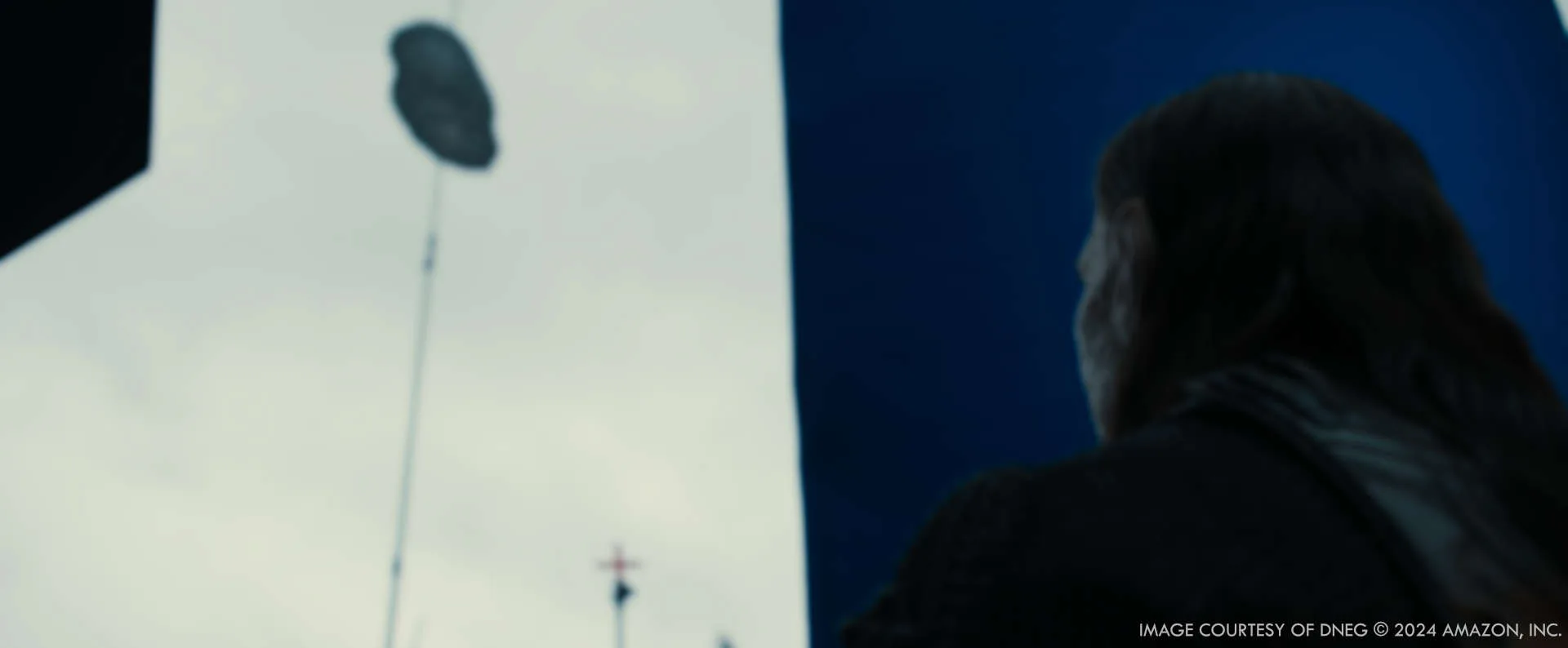
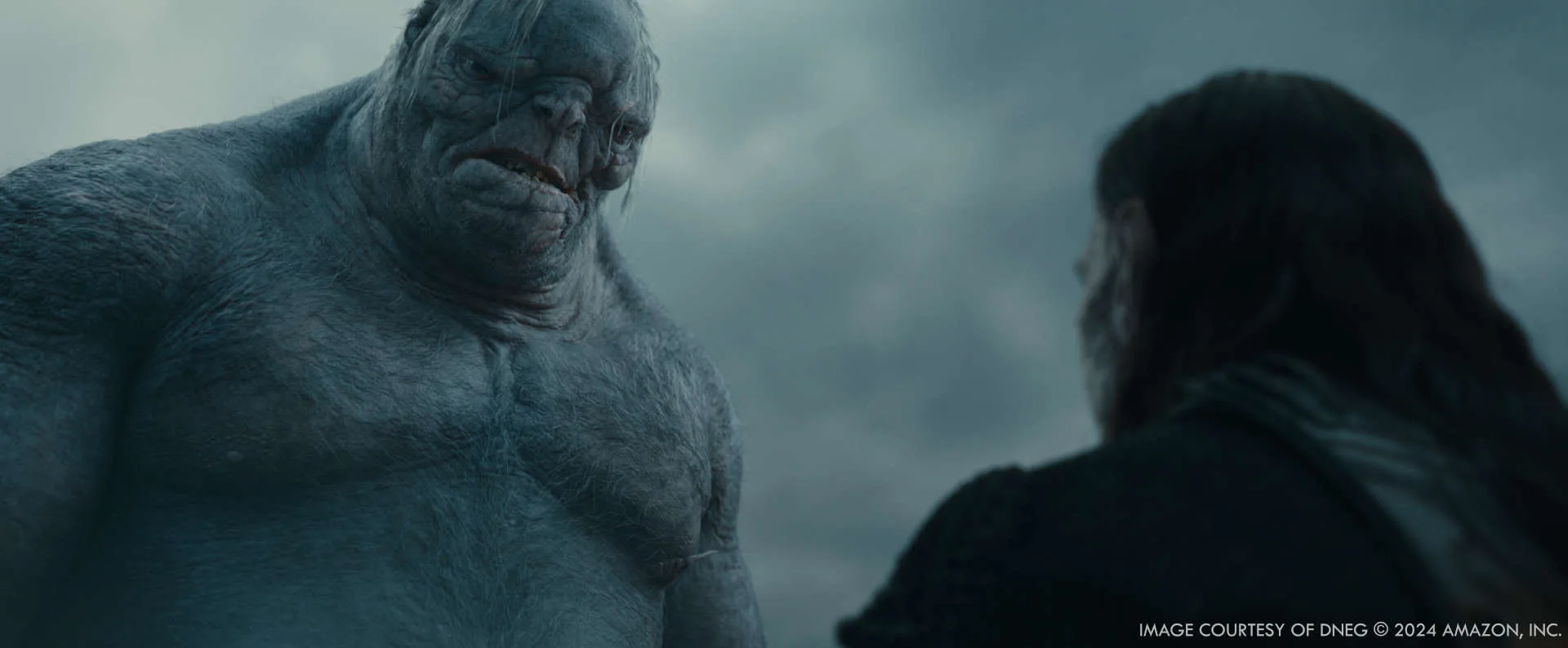
How did you organize the work with your VFX Producer?
I was very lucky to work with Michelle Teefey-Lee again. She was my VFX Producer on Season 1 at Method Studios and joined DNEG just in time to kick off Season 2 with me. Michelle and I both worked in London during the great ‘Harry Potter’ years. We’ve seen a lot of VFX facility work get into trouble over the years, we made sure to stay on top of everything and avoid the usual traps. As we often said in our management check-ins, we plan for the worst so that it never happens. In addition to our shared background in the UK industry of the late 2000’s, we have very similar instincts and attitudes about VFX work. Casting, supporting and holding onto a great crew, being up front with our client, always pushing forward, never leaving the hard stuff until later. We have lots of mantras and battle tested ideas. On a typical day, we quickly go over the big topics internal and external and then divide and conquer. We occasionally show up in each others’ meetings in support or to keep aware of the other’s challenges. We always have one voice in front of the client and crew, keeping our debates in the background. After two successful seasons together, we know we can count on each other, which makes everything much easier.

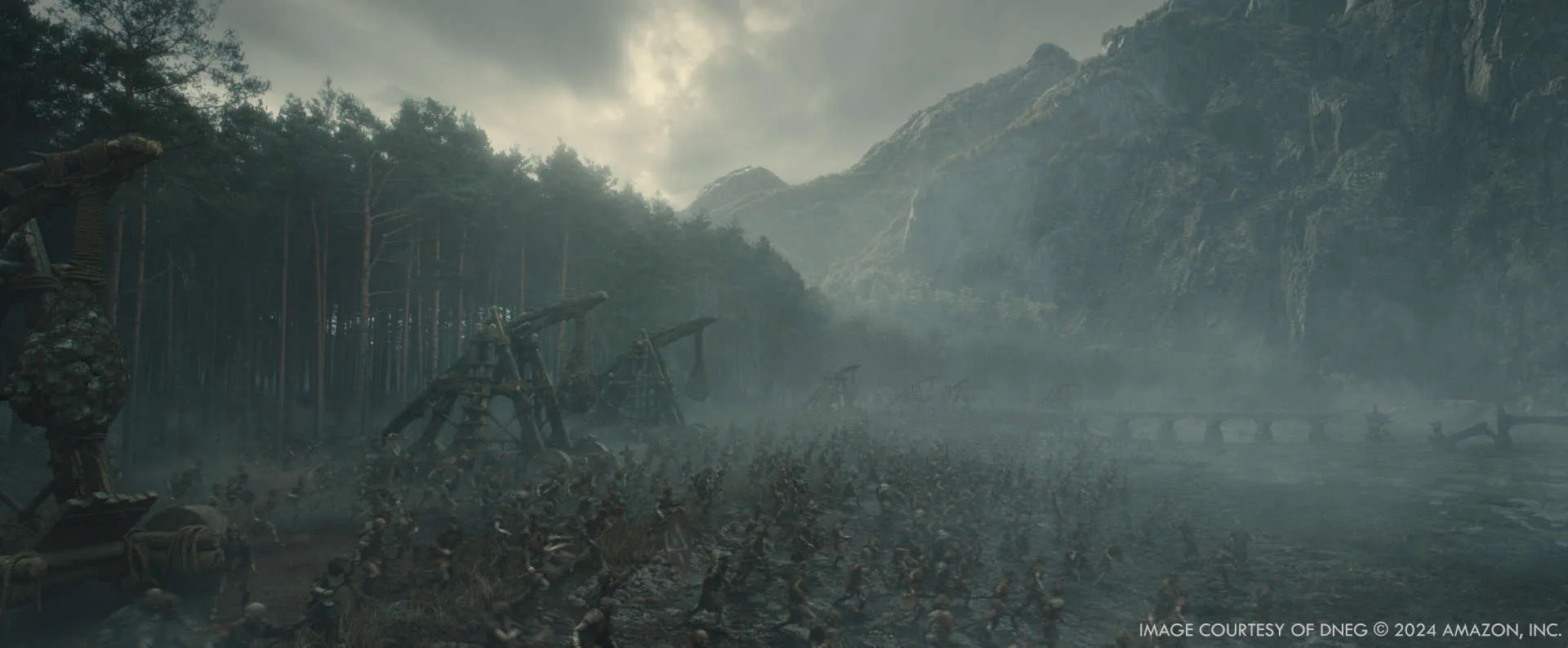
What are the sequences made by DNEG?
DNEG worked on 80 sequences across Season 2. Some sequences were only 1 shot, but a few were around 100, especially in Episodes 7 and 8. Our work was mostly a clean split from the other vendors. ‘The Siege of Eregion’ was our main assignment and we were generally given anything that happened in or around the city. We also did a couple of unrelated moments, such as the brief scene in Episode 1 where we see Sauron using black speech to befriend a warg.

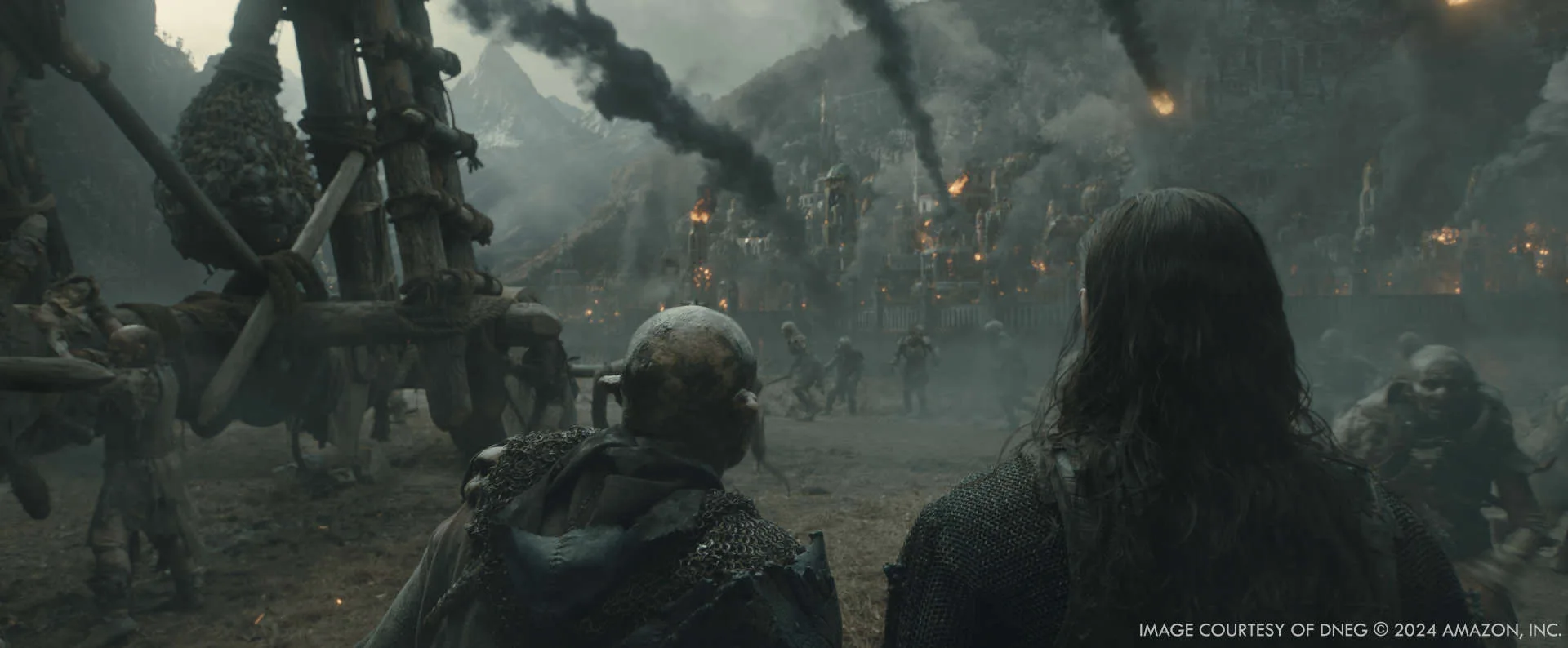
Eregion is a stunning Elven city with immense visual detail. Can you describe the creative vision and challenges behind designing this environment?
My involvement with Eregion goes back to Season 1 when my team and I were asked by Ron Ames and Jason Smith to take on the building of this new environment halfway through our production schedule. It was needed for under 10 shots, some wide establishers and some one-off closer views. It was a huge, but exciting challenge. Ron and Jason would mention occasionally that our work on the city would very likely continue into the next season, and that we should put some thought into how the city could be defended if it were ever attacked…
We were given two critical starting assets by the production; an Unreal city model from the virtual art department led by Peter Baustaedter, and a beautiful production design PDF created by the Season 1 Production Designer Ramsey Avery. The client had already worked out a great location for the virtual city to exist, a bend in the Dart River located near Queenstown, New Zealand. They placed the city in the shadow of a large granite cliffside. My long time Environment Supervisor Jules Bodenstein, studied Ramsey’s design documents intensely and briefed his small generalist environment team on the build. He worked on multiple fronts at the same time. We needed an environment that could be ready for shot work in a few months, but that was built well enough to still be viable for another few years. We had no way of knowing at the time that our Season 2 work would be at a different company and on a different pipeline. One of the key design concepts we always followed is that Eregion was designed and built by Celebrimbor over hundreds of years. It had to embody a mix of clever technology, simple architectural beauty and integrate with nature, especially trees. One of the features that makes Eregion unique is that it was built with cooperation from the Dwarves of Khazad-dûm. In the areas of the city closer to the cliffs, there are fully dwarven structures. In front of this area, some buildings have dwarven foundations with Elven towers resting on them. Closer to the water, there is more influence of Elvish designs, like those of Lindon. This includes large areas of trees and gardens.
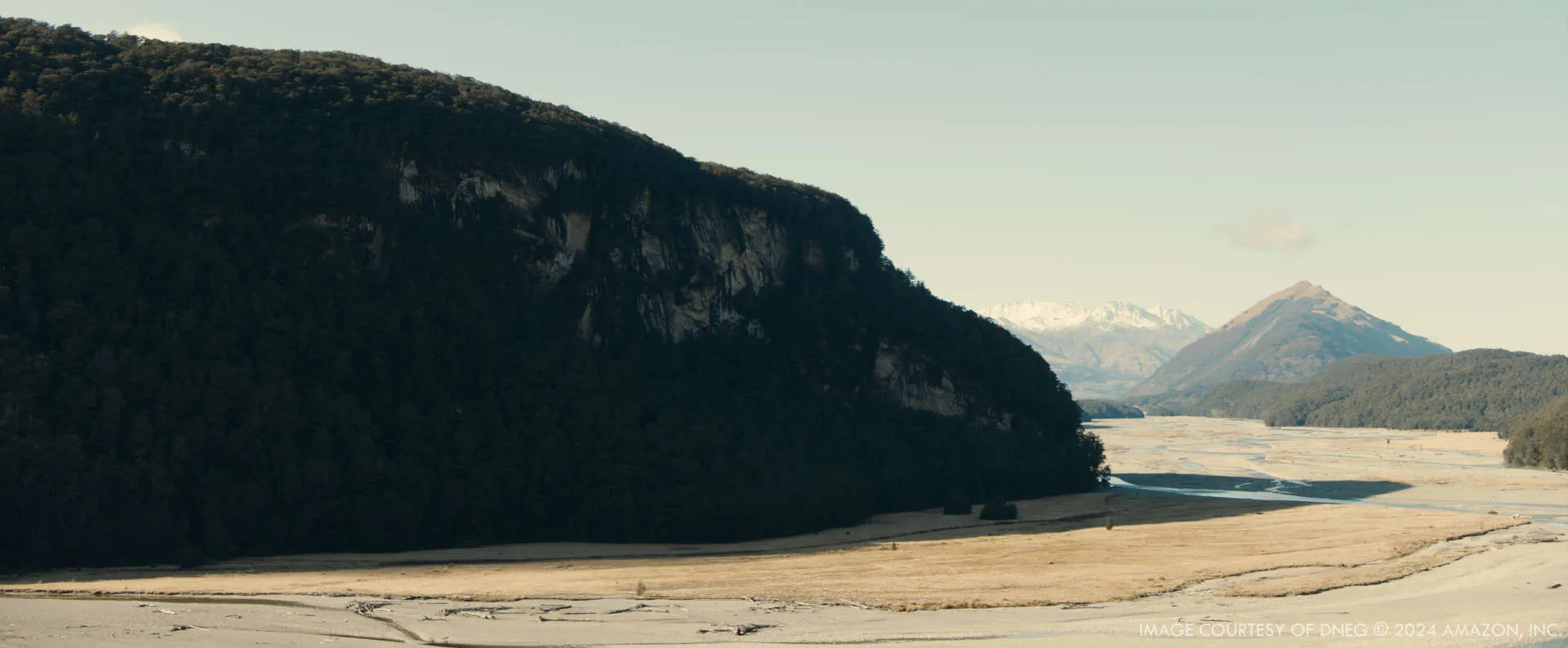
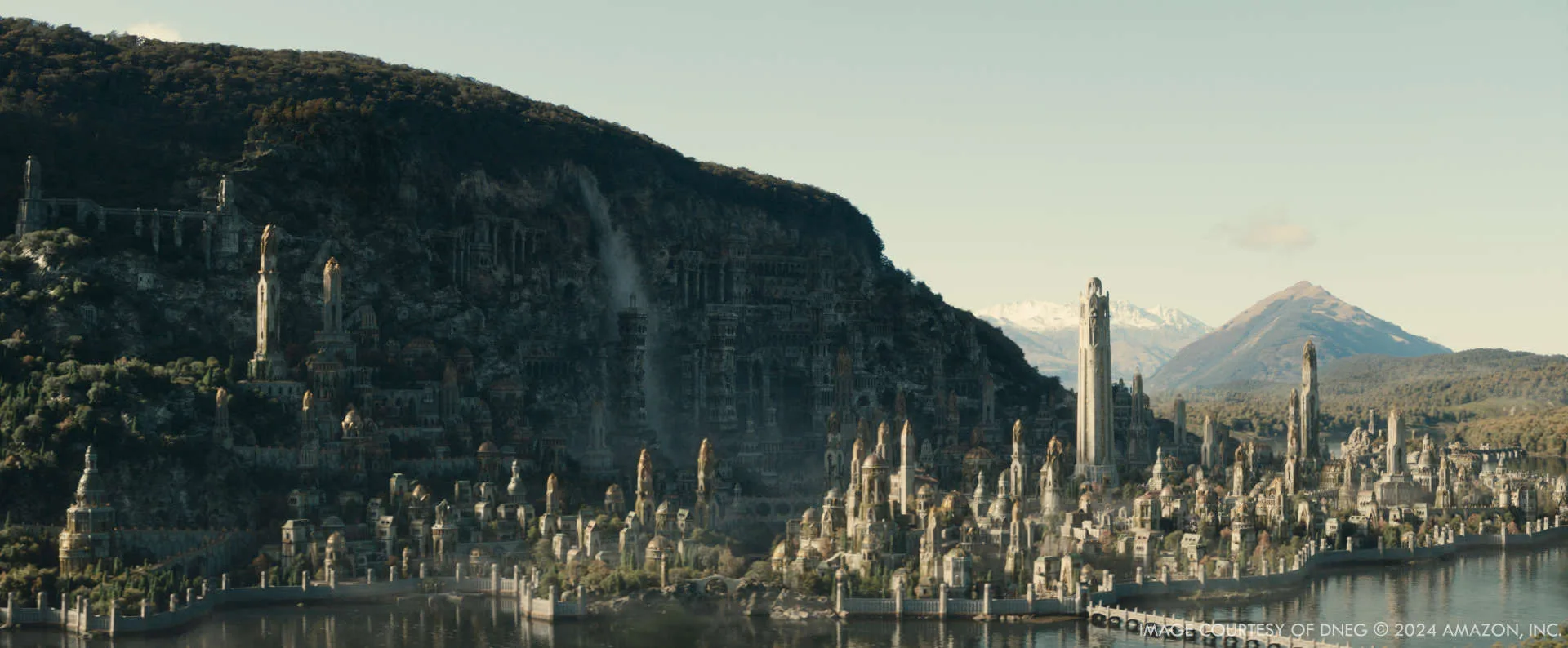
In both seasons, Jason was able to give us aerial photography as a base for most of our wide shots. This was a tremendous help in achieving realism and reducing the variables of shot design. Ironically, most of the plates used for Season 2 were the rejected takes from Season 1 that weren’t sunny enough. Once we got into Season 2, we realized the overcast plates from Season 1 were perfect for the mood and story of the new season.
For Season 2, I was lucky enough to be joined by many of the key players from the Season 1 team. Knowing the city so well, both creatively and technically, was a huge jump start for the year of work it would take to rebuild it bigger and better for Season 2. There were very few specific changes needed for the city’s initial role in Season 2. We added a defensive curtain wall around the city and found ways to incorporate the new sets being built for the shoot. We also designed and built Celebrimbor’s completed Artisan tower. The biggest new feature to integrate was the live action battle set. We ended up narrowing the virtual river to match the Windsor, UK location known as Buttersteep Rise. Most of the build work went into upgrading the complexity and quality of the city overall. We would have hundreds of shots this time, with multiple times of day, and levels of destruction.
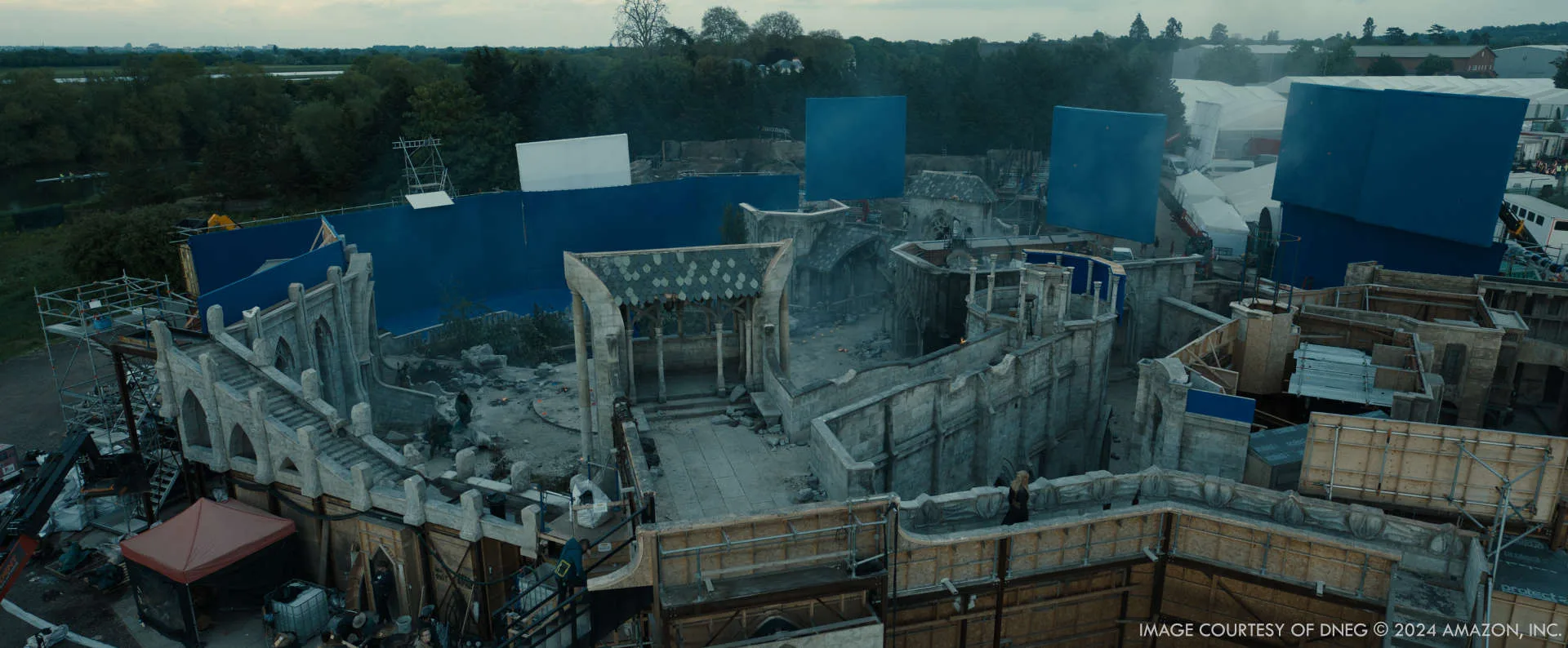

Our Season 2 methodology was about maintaining a complex and robust master asset, and we avoided cheating for specific shots as much as possible. Environment Technical Lead Yordan Petrov took on the role of ‘city manager’ from the beginning. Any addition or change to the city went through him. He would resist whenever possible doing something that would result in a custom version of the environment just to solve a specific shot issue. This paid off many times over the course of the production, especially when it came time to build destroyed versions of the city. It also made it possible to maintain a much more stable and predictable asset in the pipeline. Jules also worked with our other Environment Supervisor Gauresh Churi. In addition to building the digital versions of the sets, Gauresh’s team also looked after the building of the collapsing cliffs across the river and the revealed muddy riverbed. The design of the cliff structure had a very long development phase. Rather than designing a specific series of tooth-like rocky towers and forcing an FX simulation to create a chain reaction collapse, we bounced back and forth between the two departments, always giving FX the final word on the placement and shapes of the objects they were being asked to collide.
Jules, Yordan, and a small core team of generalists in Montréal focused on solving specific design and technical issues as they arose, destroyed buildings in particular. The destruction also required a strong collaboration with our FX Supervisors, Sébastien Quessy and Shal Joseph, as well as our Lighting Supervisors Ian Cooke-Grimes, Aleks Saraev, and Vishal Shah. The FX involvement started with the addition of small fire torch caches throughout the city that were mainly seen at night. Eventually the teams added lots of other destruction related caches such as smoke plumes and burning trees. Lighting was testing the city in parallel to make sure it was staying under memory limits and giving lighting artists enough control in shot production. Finally, the compositing team constantly fed back to everyone else on what was working and often helped decide when to cheat the last steps and when to go back to 3D. My DFX Supervisor, Marc Rice, had comped the main development shot on Season 1, so he was very familiar with the city from a 2D perspective. For Season 2, Filip Sustek looked after all of the big establishing shots of Eregion as our Compositing Supervisor.
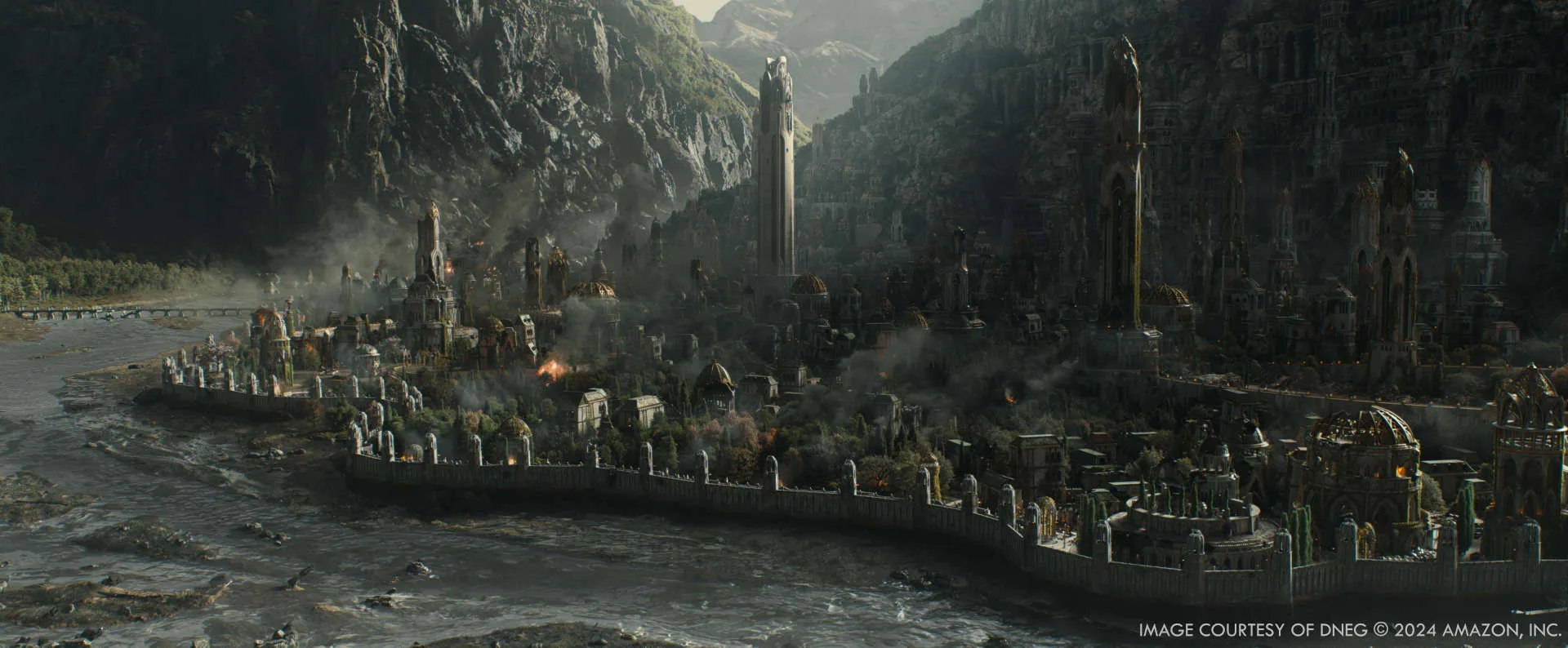
How did you balance the ethereal beauty of Eregion with the practicality of creating it as a believable, living city for the series?
Working in the fantasy genre is always interesting when it comes to images of ‘ethereal beauty’ and other concepts that can work against realism or believability. You want to take the audience with you to a new place, but don’t want to lose them on the journey. If everything is working well – acting, writing, music, photography, etc. – you can stretch a little further into looks that go beyond what’s familiar in the real world. The best starting point is to stay within photographic reality, but push all the tools available. Bright warm backlight, a little slow motion, some floating pollen in the air, maybe even a touch of glow on highlights. We had to be very sparing with using too many enhancements that would make the images look forced and cause the audience to question the reality of the world or notice any single technique. One of the most interesting aspects of visual effects is reality versus filmic or photographic reality. There’s no set formula for this and audiences’ tastes are constantly changing and evolving. The moment in Eregion that I think about here is when Celebrimbor walks out of his tower while under Annatar’s illusion and sees a courtyard full of his people doing idyllic Elven things; painting, drawing, reading, playing. This was our moment to show life in Eregion as it had been for centuries, working with nice photography and adding CG backgrounds full of nature and classic Elven towers. We called this ‘pristine Eregion’ and it was the first version of the asset we completed.
We return to this same place later when the illusion is broken and Celebrimbor sees the city as it really is – under siege with its beauty being buried in smoke and rubble. Hopefully both of these looks have a believability to the audience. Our other DFX Supervisor Nihal Friedel worked with his team to create these courtyard scenes, using the same master asset as the big wide shots. Compositing Supervisor Sneha Amin was in charge of the comp work, and she made sure that we never went too heavy on any treatments that would push us into too dreamy a look.
I’d also like to mention something about the city’s population. It sometimes seems like there’s not many people around for how large a place it is. I’ve always felt that Elves don’t live in crowded environments. As an almost immortal race, they don’t have large families and spend much of their time in pursuit of wisdom and knowledge. They prize large spaces where they can wander in thought and spend whole days on various projects. We didn’t want to put crowds of Elves scattered throughout the city just for the sake of making it look lived in.
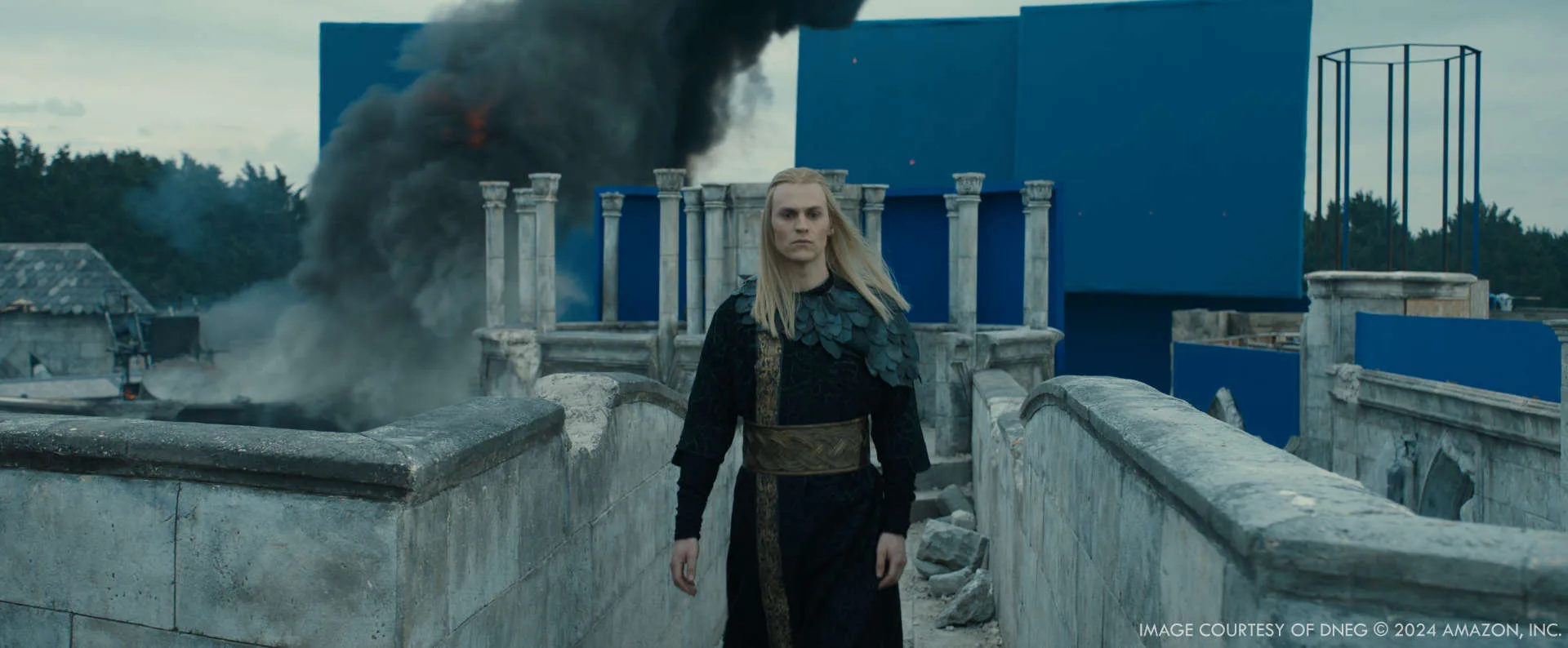
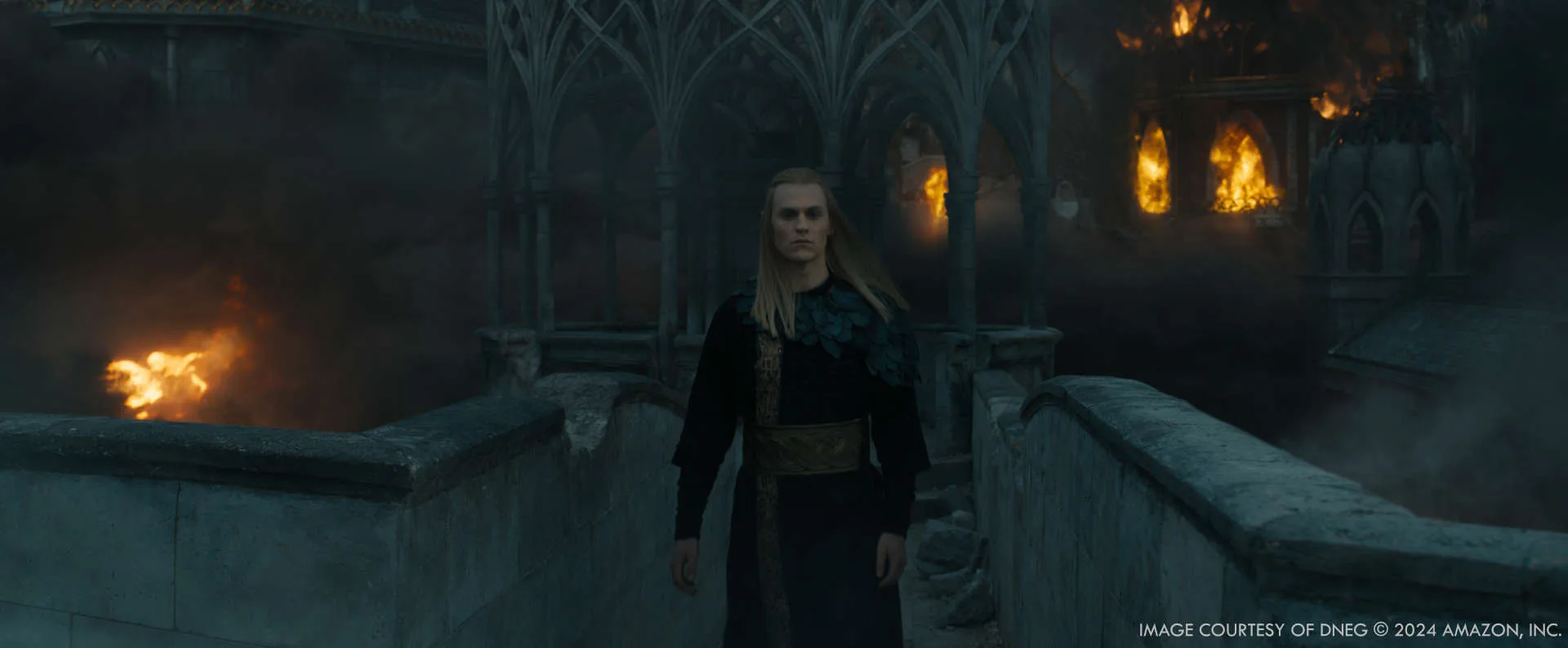
Can you walk us through the technological processes used to construct the city digitally? Did you incorporate any physical sets or miniatures for reference?
At the start of our Season 2 work, Yordan Petrov went through the whole Season 1 asset and ingested all the usable components into DNEG’s new USD pipeline. There were a lot of things to re-do, restructure, and optimize. One of the biggest optimizations was to use a games technique to texture all the assets. We had one material per texture type which was then used over all assets using UV layouts instead of projections such as triplanar/pxr round cube. This enabled every single asset/building to access a single brick marble texture, drastically minimizing memory and texturing time. The rebuild was a lot of work, but it allowed us to make a fresh technical start, with the advantage of having finaled Season 1 shots to match. We didn’t have as many variables to consider since we weren’t building it for the first time. The city was structured with twelve independent zones so we didn’t have to load everything for shots that didn’t have a full city view. Season 2 needed more CG zones as we previously relied on photography or digital matte paintings (DMP) for the environment around Eregion. There was also a lot of work done to improve the amount of instancing Renderman could give us and culling geometry not seen in the camera frustum. As usual, we had to be careful with this as items outside the view often affect scene lighting. While the rebuild was under way, Jules Bodenstein had his team refining many of the structures as well as building new ones to support more hero views and previously unseen areas of the city. Gauresh Churi was assigned the task of creating digital versions of all the live action sets. These needed to be merged into the existing city and look the same in wide fully digital shots as they did in live action closer shots. It was fun trying to find the right place to put the various courtyards and wall sets. Jules would find a good location, then see how it played in various shots before getting me and Jason to approve it as a final position. Then a pass of digital set dressing would be done to make it look like that area had always been there. This often involved adding trees, paths, and benches. As an additional layer, the environment team scattered and placed braziers and torches all around the city and within each building. Inside all these torches were locators that were swapped for FX simulated fire caches at render time. For the various versions of city destruction, building damage was controlled through a Houdini setup using simple intersecting shapes to create highly art-directable damage whilst also generating broken edges with procedural scorch marks. Much like the buildings, the tree damage was also controlled in Houdini using simple shapes to ‘burn off’ leaves and smaller branches whilst also discolouring the surrounding leaves to give a realistic burnt look.
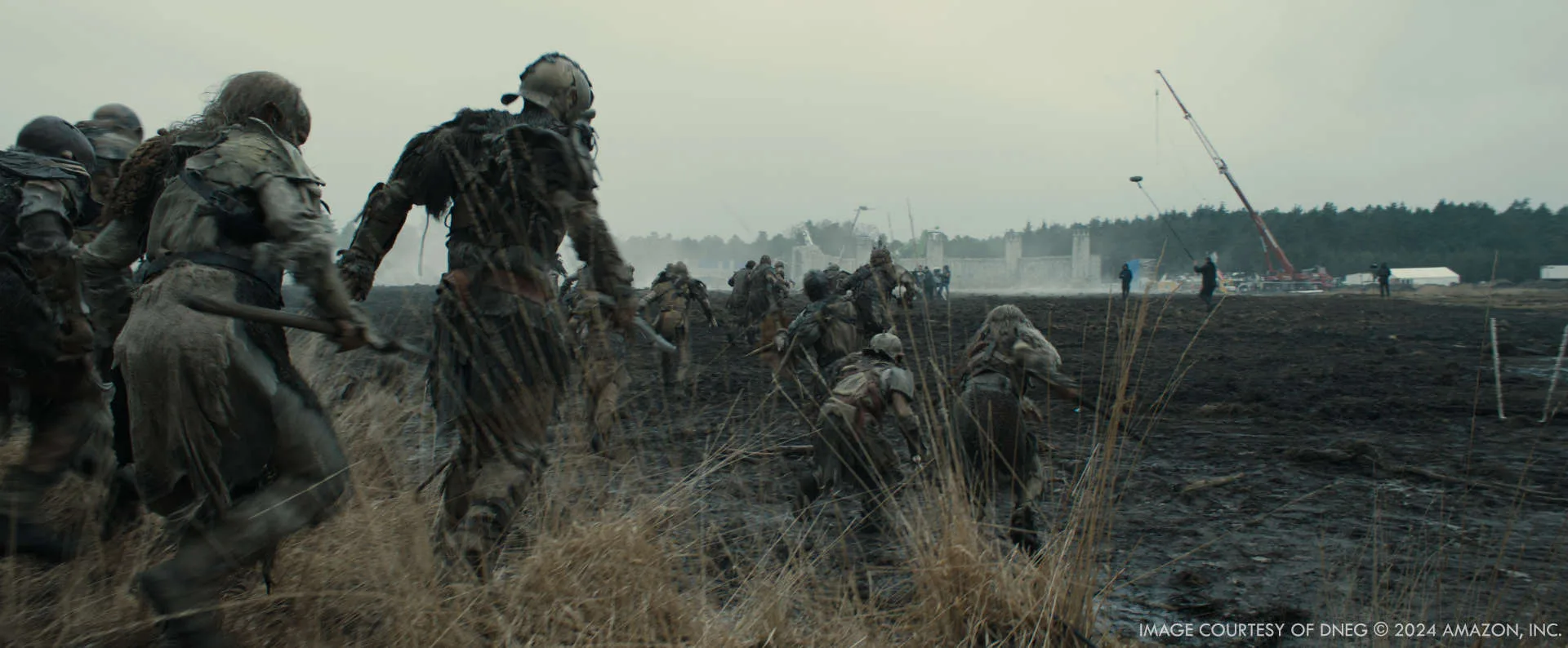

Damrod the troll is a standout character. What went into designing his look, and what inspirations guided his visual style?
Jonathan Banks’ portrayal of Mike Ehrmantraut in Breaking Bad became our primary attitude reference. It became such a good fit for the character. We also looked at tall actors with a lot of screen presence, like Ron Perlman and André the Giant, for their powerful lumbering strides and balancing arm swings.
We came up with these ideas while working out his Episode 3 introduction scene. There is very little Damrod needs to do here – walk into the Orc camp, push a beam out of his way, and then say a line back to Adar. I don’t come from an animation or acting background and I was really struck by how much is actually conveyed in this short scene due to the acting choices we made. It’s his lack of movement and his seeming disdain for even having to say his line that portrays how misanthropic and world weary he is.
When we got to the battle, that short character sketch gave us a lot to work with. Once he is sent into the battle, he is single minded and just wants to find the quickest way into the city. The Orcs aren’t his teammates, they’re just something else in his way.

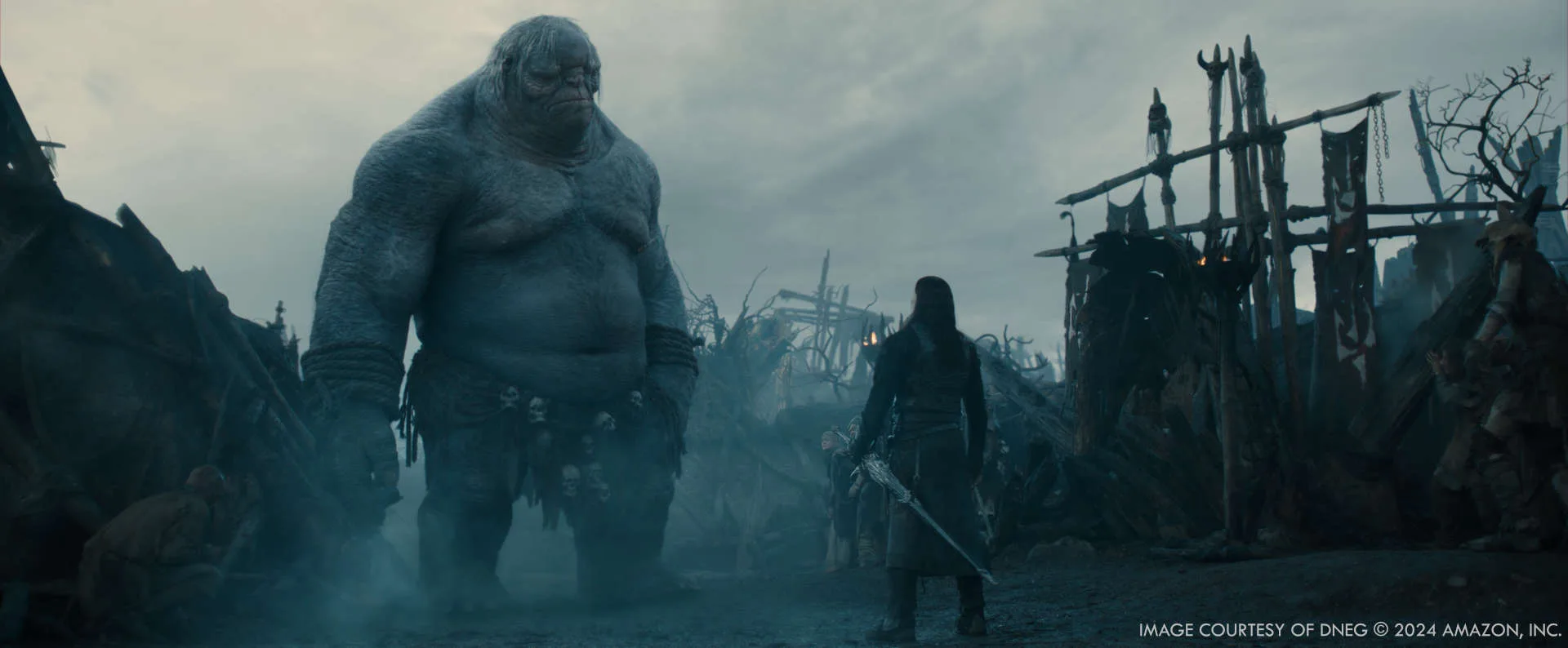
How did you blend practical effects with CGI to create Damrod? Was motion capture used for his movements, and if so, what challenges arose in animating his size and weight convincingly?
There were only a few moments where Damrod interacted with the real world. The rest of the time, we just left a wide enough area clear and an eyeline pole moved through the set at an appropriate pace. We spent a lot of time in shoot prep working out which would be practical interaction moments and when we’d just keep it loose and handle all the interaction in post. When Damrod first enters the battlefield, he grabs an Orc, bites off his head and tosses him away. That’s obviously a digital double and we had the Elves and Orcs on-set fighting with a Damrod-sized hole left in their midst. We cut to close-ups of his feet stomping through the mud and there’s two choreographed SFX moments that we added CG feet to. For those shots, a stunt Elven warrior is lying on an airbag that quickly deflates so that he appears to be pushed into the mud by a troll foot. We even got some usable FG mud splashes from the proxy troll foot that our SFX Supervisor puppeteered in camera. I find it works really well to have a combination of shots that lock you into what was shot and some that are left loose enough that the action can be resolved in post. After a rough cut of the sequence was put together, there were some additional beats shot on a bluescreen stage. The most significant ones Jason named the ‘inhuman shield’ and the ‘guitar solo’. The shield moment is when Damrod gets annoyed by all the arrows Arondir is sticking in him and he pulls two Orcs up to soak up the attack. The Orcs were practical and we reverse engineered the troll animation into the footage. We had to jump through some hoops in terms of their movement and lighting, but it was nice to have real stuntmen in the shot reacting to the virtual arrow hits. The guitar solo is a big panning shot that connects Damrod’s entrance with the city wall and the fight going on in front of it. It was done with multiple motion control passes to capture a number of stunt events. These were all stitched together and then massaged into place once we had some good Damrod lumbering and kicking animation. We filled up the mid and background with lots of digital fighting vignettes.
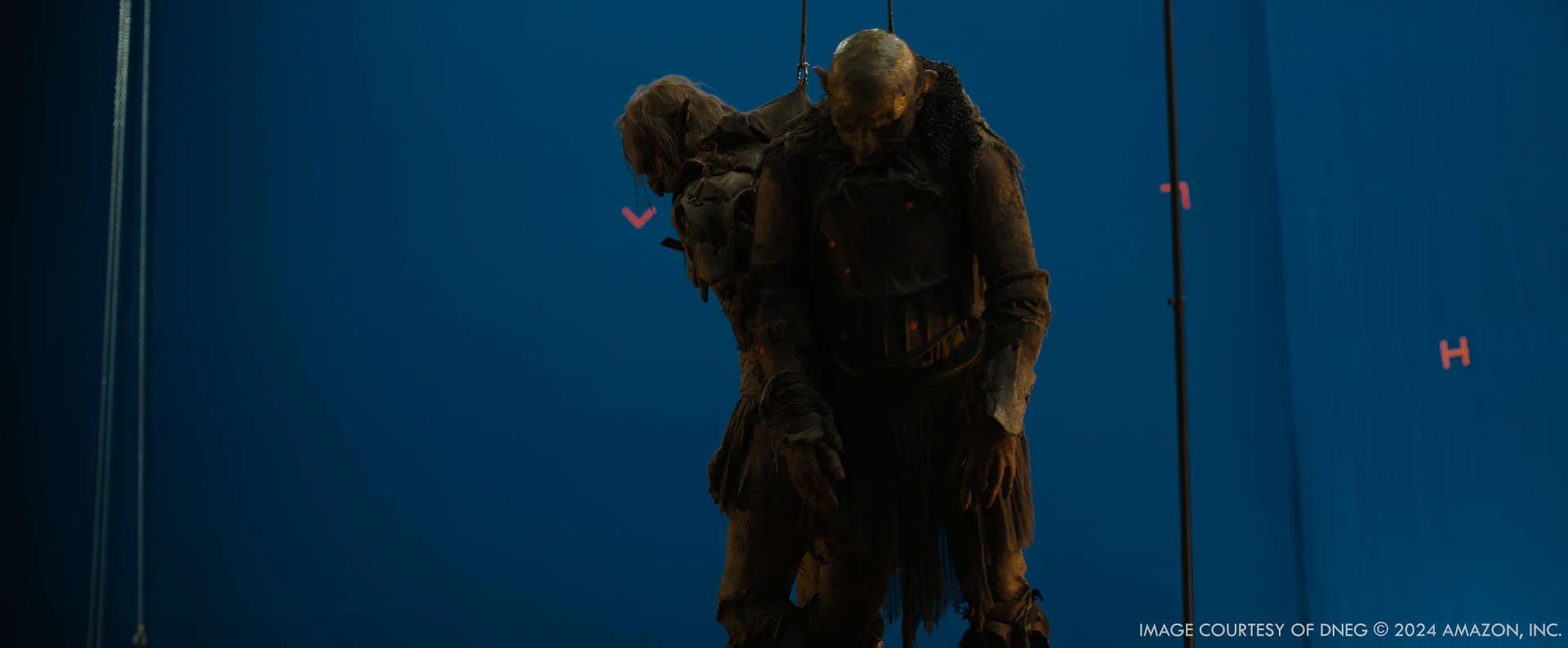
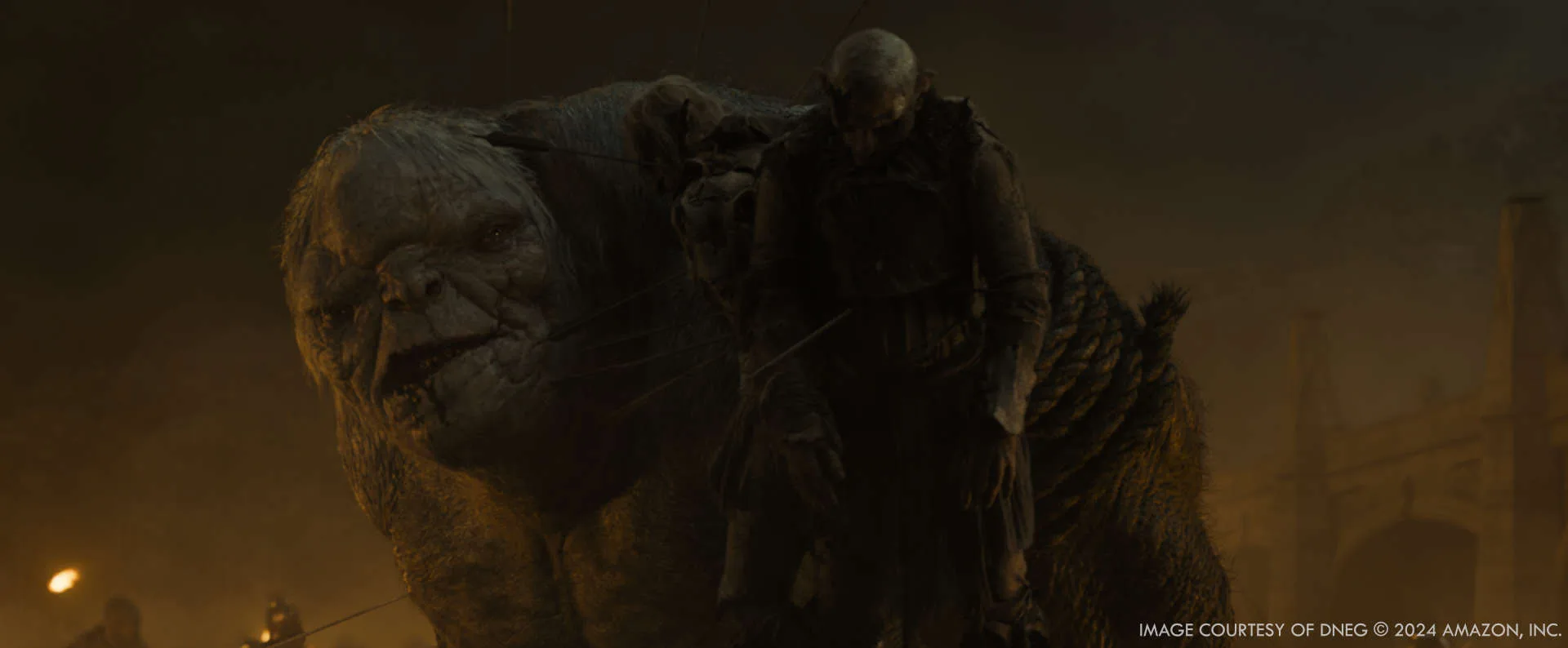
We never really considered motion capture for Damrod. We felt that, in addition to finding a performer and getting the right recipe for motion re-targeting, we would also owe a lot of motion editing for ground interaction and contact with real and virtual objects. It took a while to find the right key frame balance of stride, hip rotations, arm swings, and other indications of size and weight. But, once we had an approved cycle, the animators could branch off from there for the specific shot moments.
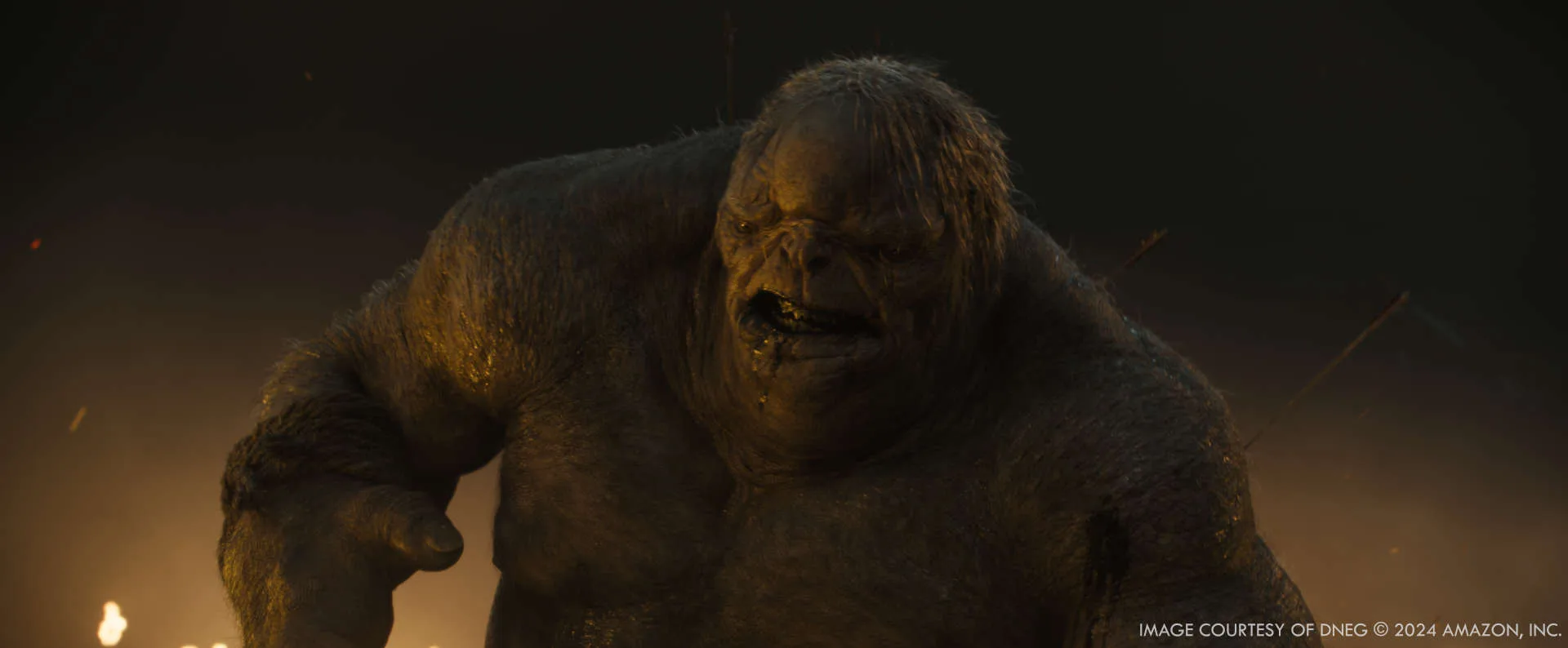
Looking back on the project, what aspects of the visual effects are you most proud of?
What I’m really the most proud of is that everyone on our global team of hundreds enjoyed the experience and worked so well together. I’ve been doing visual effects for a long time now and I don’t ever take for granted that a project will be a good experience for the crew. I’m still getting positive feedback from the Season 2 crew today and everyone is hoping that we can all work together again soon. I want to first thank my Amazon clients, the showrunners and Producers Jason Smith, Tim Keene, James Yeoman, and their whole team who gave us so much trust, support and friendship. Michelle and I made sure that our crew were aware of that positive relationship and the importance of holding up our end of it by keeping up our effort and care at all times. The DNEG senior management team, especially Puja Parikh, Amit Sharma, Emma McGuinness, Adriano Rinaldi, Merzin Tavaria and Rohan Desai, really let us run the project using our instincts and experience. They left us to it, but were ready to help whenever we asked. We couldn’t have done it this way without a great supervision and production team. From the very beginning we made sure that all departments looked up and down the pipeline and always talked to each other, never just throwing their work over the fence without making sure it worked for the next person. Attending internal reviews was very gratifying when I saw evidence of that attitude and saw the quality and efficiencies that resulted. Of course, creating great images that add to the visual history of Tolkien’s work brings me great joy, but if it had come at the cost of artists that never wanted to do it again it would have been a great disappointment.

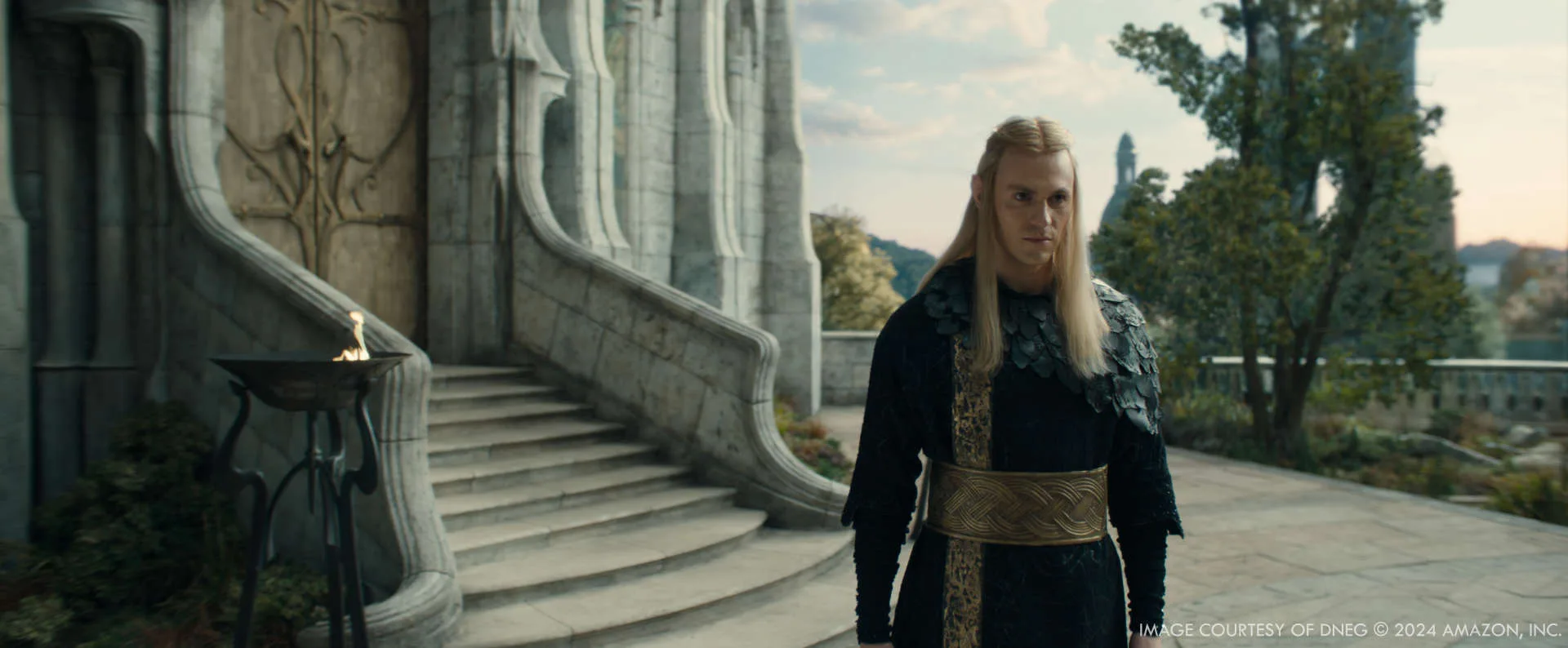
Which sequence or shot was the most challenging?
Our biggest shot was definitely the opening of Episode 8. We start by looking into a dramatic sky and follow smoke plumes down to see across the battlefield as the remaining trebuchets fire into the heavily damaged city. We blend from fully digital into a minute long single camera take and hand back to digital at the end. The camera is led through the city first by invading Orcs, then by an Elven archer, and finally by Galadriel leading refugees to safety.
This shot was turned over soon after it was shot and we only finished it in our final weeks. It wasn’t worked on every day but one steadfast Compositor, Kuba Pruszkowski, did have it on his plate the whole time and would build up the layers as they came in. It wasn’t just the man hours necessary to create and blend all the pieces, it was also the creative decisions that needed to go into this scene. Every department contributed elements after having built up looks and techniques in other smaller shots. It’s a true kitchen sink shot!
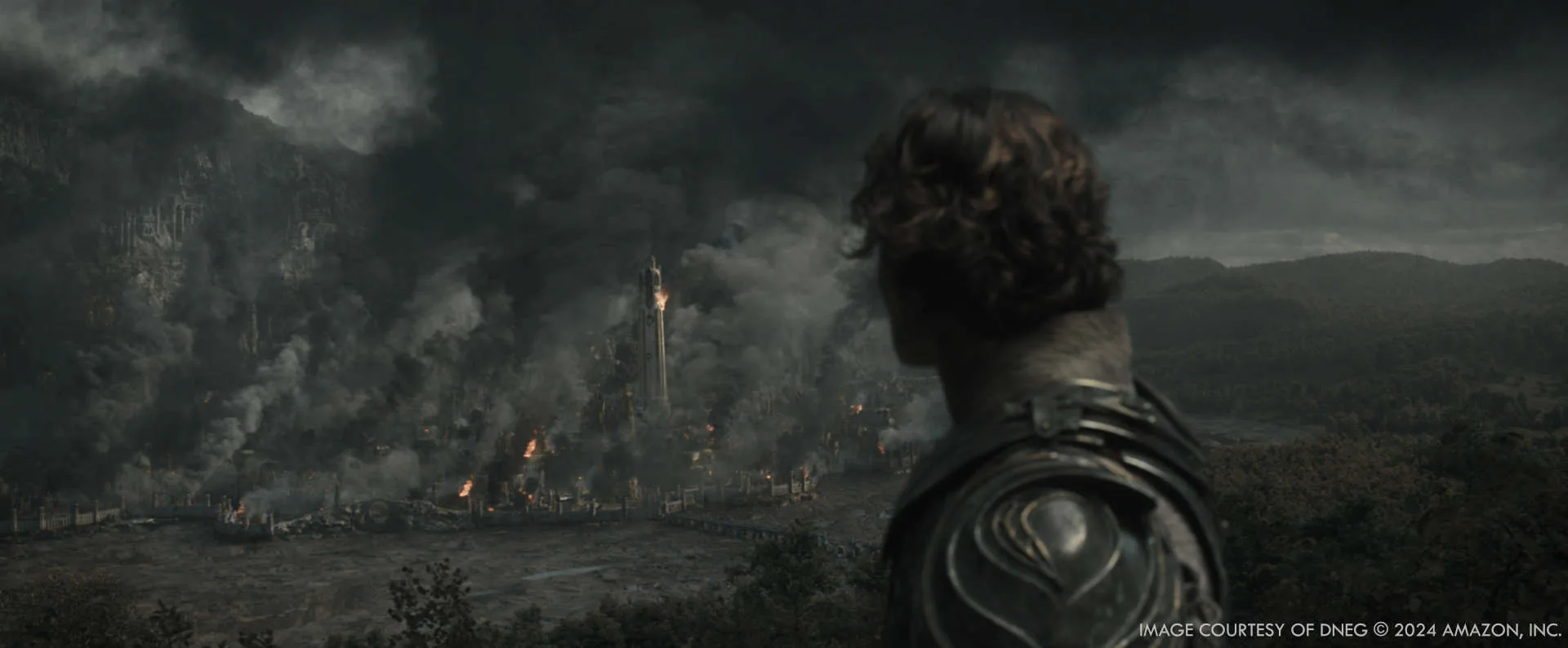
The final look of the whole shot came together once we had worked out how the world would look from the cliffs above, where Galadriel and Sauron are duelling. We got some great concept frames from the client VFX Concept Artist, Einar Martinsen, that showed how this big opener could link to the later scene and emphasize areas of the frames dramatically as we moved through the city environment.
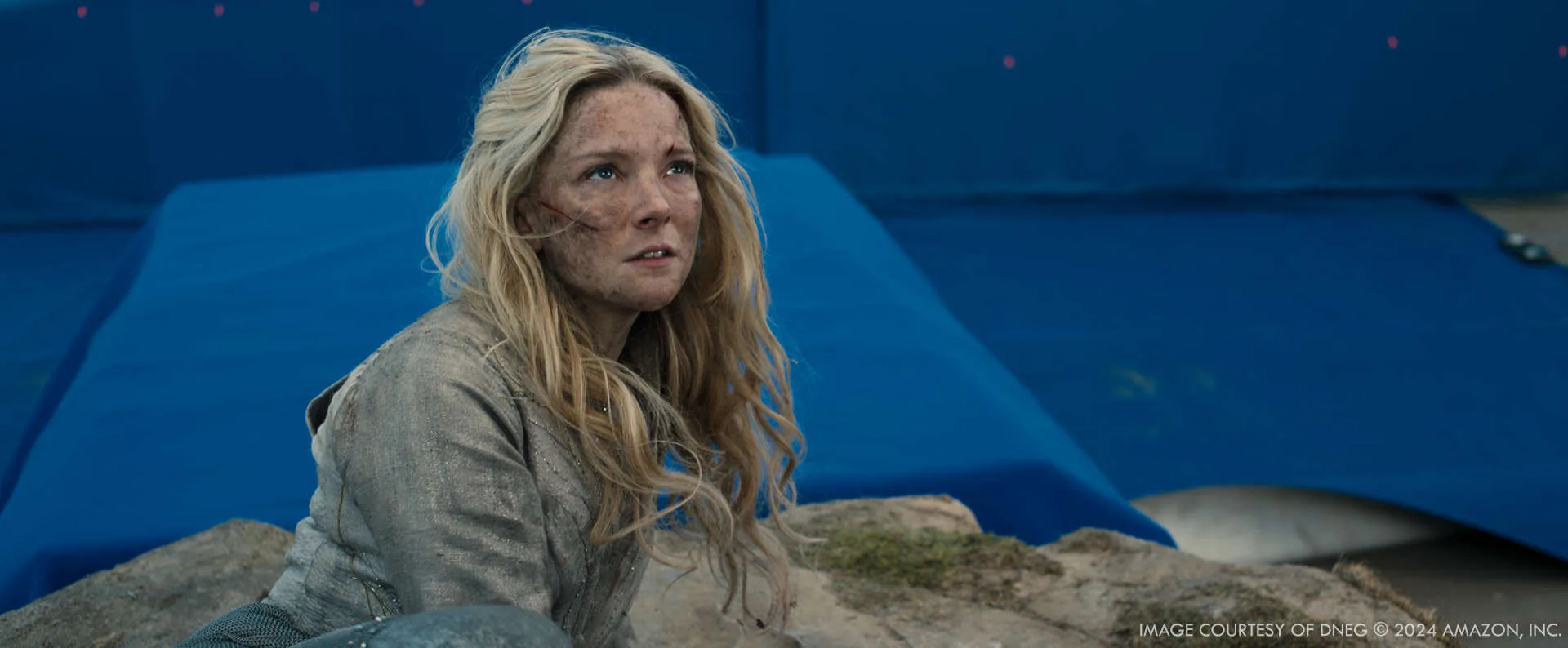
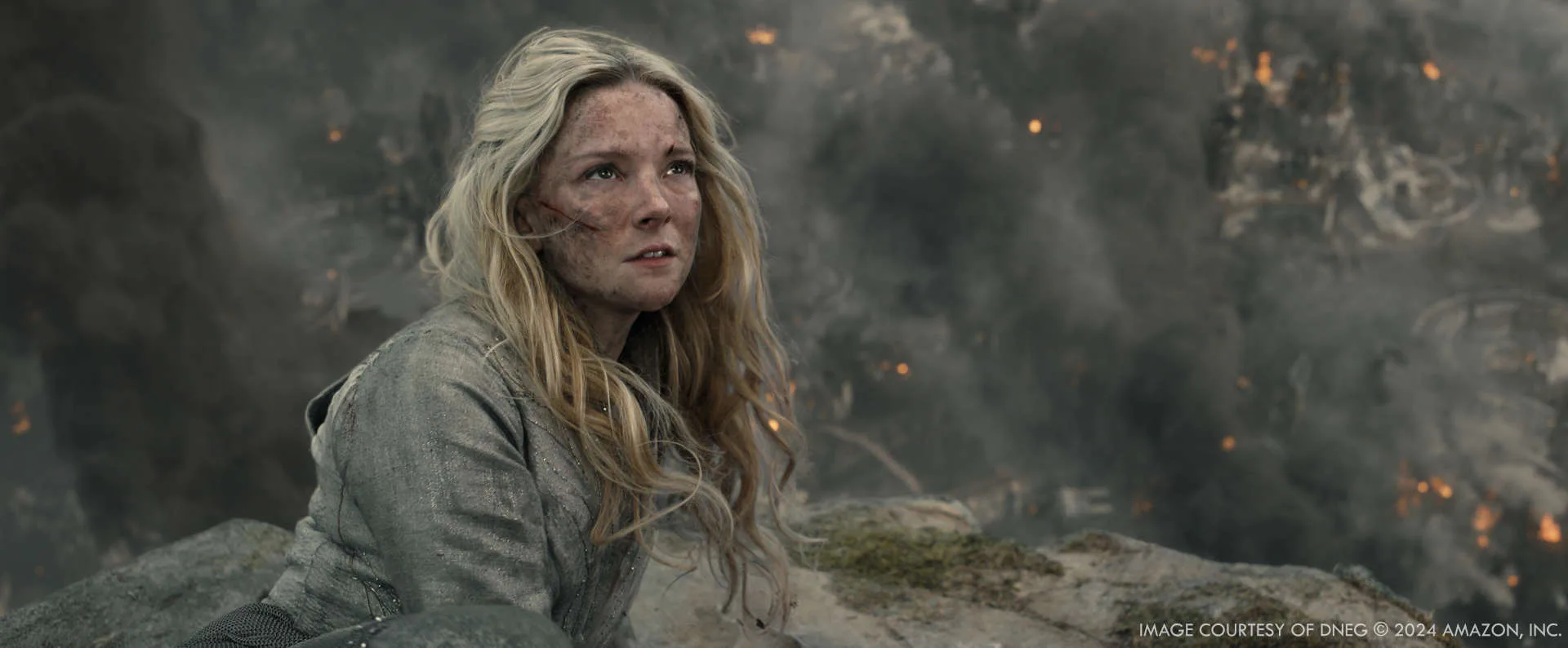
Is there something specific that gives you some really short nights?
Nothing specific. Throughout post-production we faced creative and technical challenges; a single shot or effect we couldn’t make work, a sequence that was still in search of a look, a sudden trailer deadline. I had such a good crew that we planned for those things constantly. Not knowing what or when, but having built in spare time and resource for the inevitable surprises. Our Senior Production Managers, Val Kenol and Stefan De Souza, were always reviewing resources and schedules to make sure we weren’t caught short. Despite all the planning, the thing I can never shake off is the fear and apprehension of that last minute phone call. When someone high up in the food chain suddenly decides that what we’ve been doing isn’t right, doesn’t work, etc. It’s almost never happened in my career and has yet to happen on The Rings of Power. But that background fear keeps me pushing. If I get complacent, that’s when it will happen.
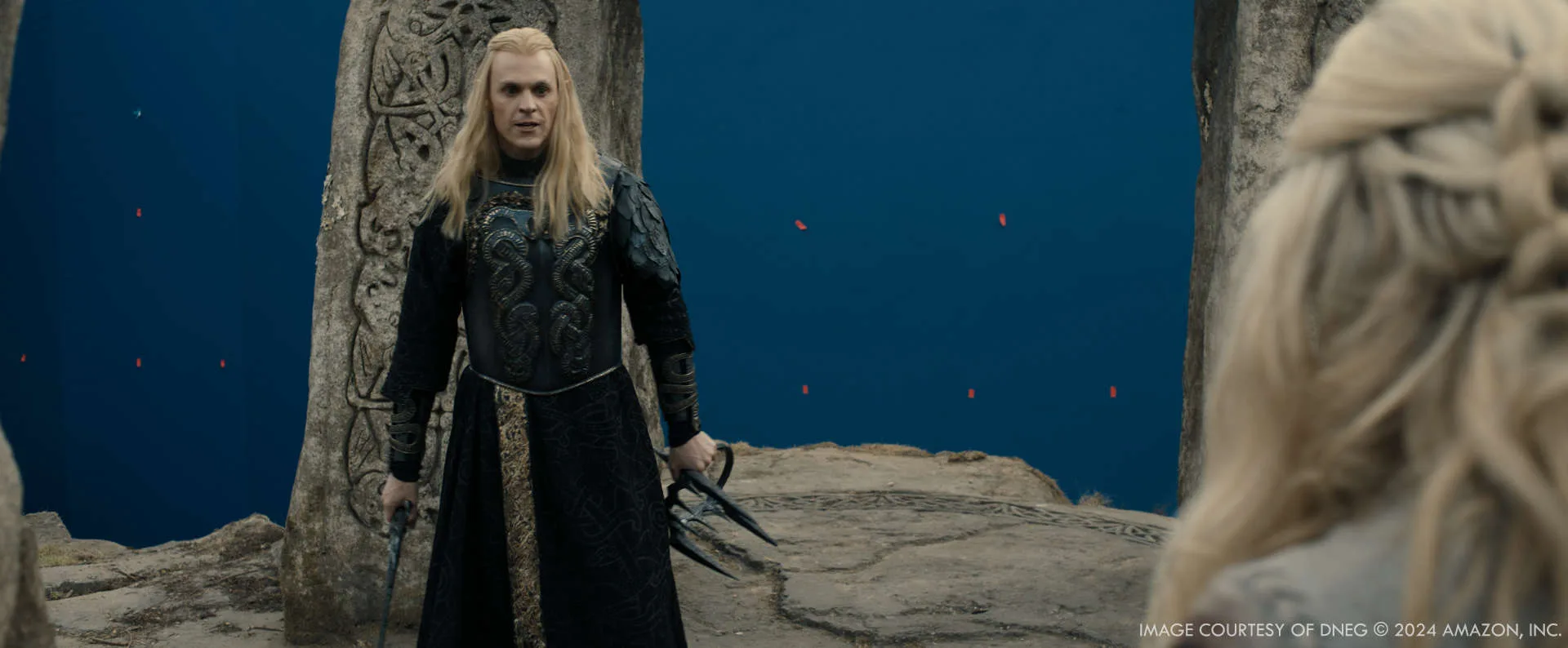

What is your favorite shot or sequence?
I never got tired of reviewing our big Eregion establishing shots. There’s so much detail and history in each frame. By history, I mean the years of building and evolving the city asset across the two seasons. Though I could easily pick from a number of them, the very last shot of Episode 1 is a helicopter flying right to left, looking at the city as foreground trees interrupt and eventually wipe the frame. Our layout team, supervised by Florian Mignet, did many iterations of the FG trees to get just the right visual rhythm that Bear McCreary could cue off of and take us into the episode credits. I didn’t know until I was watching Episode 1 with my family that the shot would end that week’s episode. It was a great surprise.
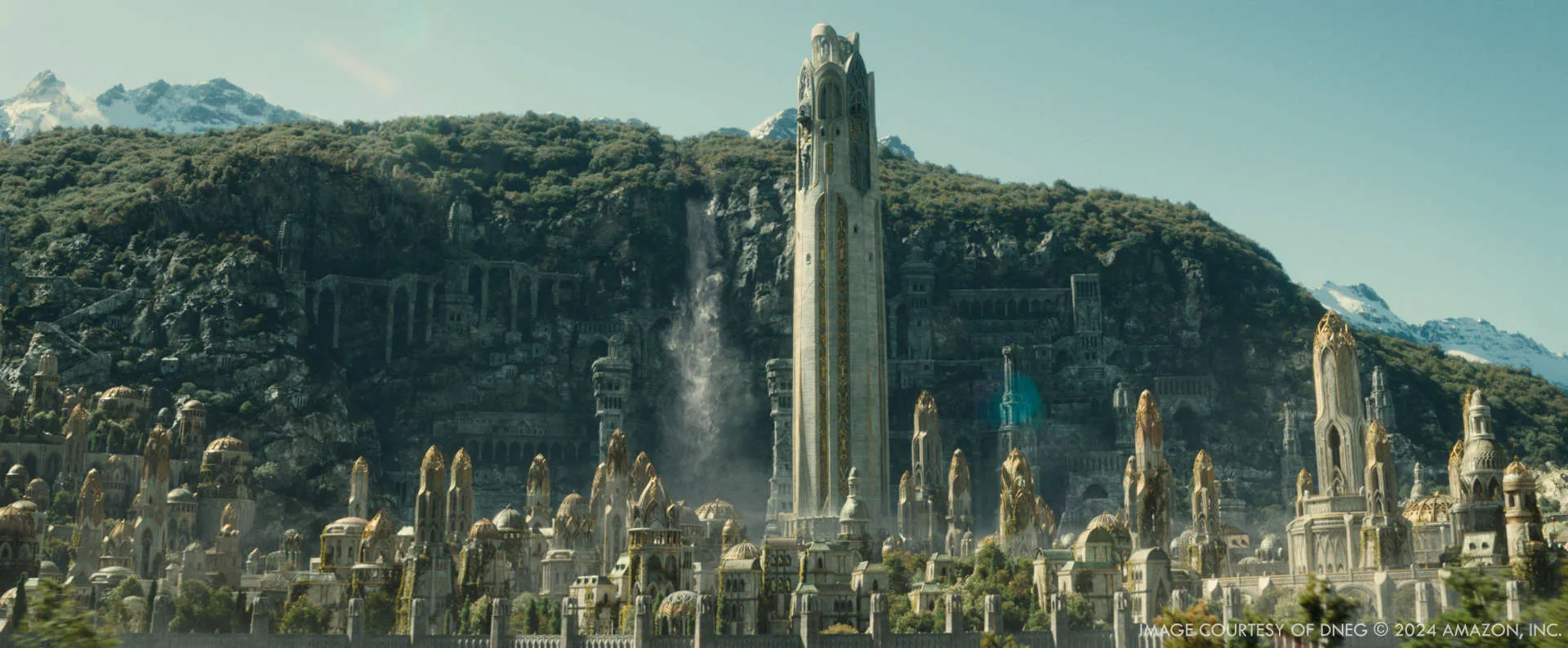
What is your best memory on this show?
For specific moments, it’s hard to beat the sensory experience of being on-set for the filming. I was present for two months of the second unit battle work. We had a great VFX on-set crew, led by Richard Bain. Everyone on that shooting crew was great and I soaked up all the information and memories I could to inform and inspire our post work. The Second Unit Director was the legendary Vic Armstrong and it was a great privilege to watch him design shots and lead the unit. I had wanted to work with Vic ever since I heard stories from friends who were with him on the 1996 Starship Troopers shoot in South Dakota. We spent a lot of our time on-set standing in thick mud, usually the cold and gooey variety.
One particular night I remember really well was when our last shot was the big explosion at the siege machine (called the ‘Ravager’). Earlier that night we completed great shots of Selina Lo (as the Elven archer Rian) being hit with Orc arrows and collapsing into the mud. I was really impressed with her stoic performance and level of tolerance for the cold and wet conditions. When it was time for the big stunt/SFX shot where she fires off her last arrow at the oil barrels, it began to rain so heavily everyone went under shelter to wait it out. The rain eased up and Vic decided we could still get the last shot. SFX set up the charges and a group of stunt performers prepared safety gear and slathered on fire gel. The crew pulled back to safety and then we rolled on a single amazing take. The Rian stunt double is silhouetted by fire as stunt Orcs fly through the air covered in flames. In post, we realized that the rain in the shot was very visible and there wasn’t rain in surrounding shots. We embraced the added drama of the sparkling rain and added digital rain to the following shots. It’s hard to recreate these organic and spontaneous live action moments when you’re in post just using computers.
How long have you worked on this show?
I started in November 2022 and we completed our final shots at the end of August 2024.
What’s the VFX shots count?
DNEG completed 936 shots across the 8 episodes. Most of our work was in episodes 6-8.
What is your next project?
We’re currently discussing work for Season 3 of The Rings of Power and I’m looking forward to finding out how we can contribute to another exciting installment.
A big thanks for your time.
WANT TO KNOW MORE?
DNEG: Dedicated page about The Lord of the Rings: The Rings of Power – Season 2 on DNEG website.
© Vincent Frei – The Art of VFX – 2025




